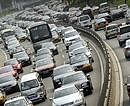
State television broadcast images of a long line of mostly cargo trucks inching slowly through Inner Mongolia on a major highway leading toward Beijing that has come to symbolise China's traffic gridlock problem.
"You could say the highway has become a big parking lot," a CCTV reporter at the scene said, estimating the number of vehicles stuck in the congestion at more than 10,000.
The stretch of highway linking Inner Mongolia and the northern province of Hebei with Beijing is among the nation's busiest as the capital of more than 20 million people sucks in huge shipments of goods.
Major snarls have materialised recently, which have been blamed on highway maintenance projects and accidents.
Traffic slowed to a snail's pace in June and July for nearly a month, according to earlier press reports. In August, state media said some drivers were stuck in a huge traffic jam on the route for nine days.
The traffic subsequently cleared but has worsened again due to accidents and traffic restrictions imposed by authorities, CCTV said.
China has embarked in recent years on a huge expansion of its national road system but the volume traffic periodically overwhelms the grid.
According to government data, Beijing is on track to have five million cars on its roads by year's end. The four-million mark was passed in December.